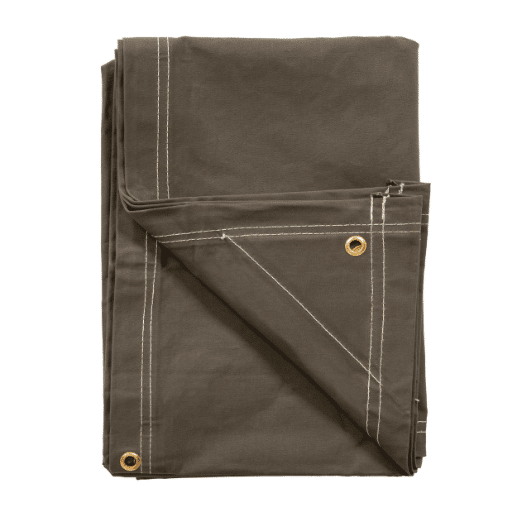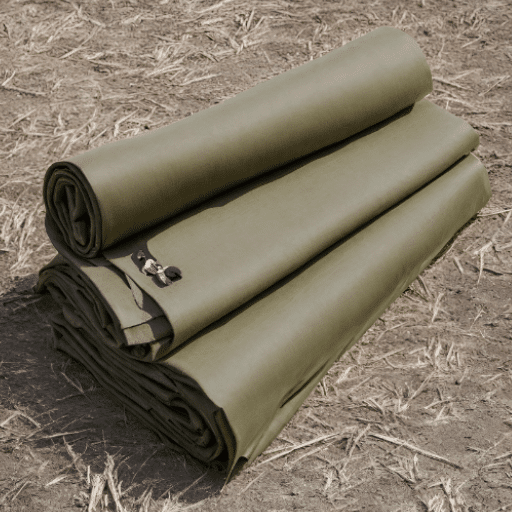Anyplace where there are valuable assets exposed to the elements, heavy-duty waterproof tarps are a protective option used in many industries and everyday applications. Be it protecting construction materials, covering equipment, or making provisions for outdoor events, the sturdiness and water-resistant qualities render these tarps an indispensable solution. On the other hand, the choices are numerous and bewildering to select the right tarp for one’s needs. This guide will help you ease the decisions by looking into essentials about the best heavy-duty waterproof tarp: features, materials, and use cases. By the time this article is over, you should have enough information to know how to choose one tarp that will genuinely come through for you when tested under the harshest of conditions.
Understanding Heavy Duty Waterproof Tarps
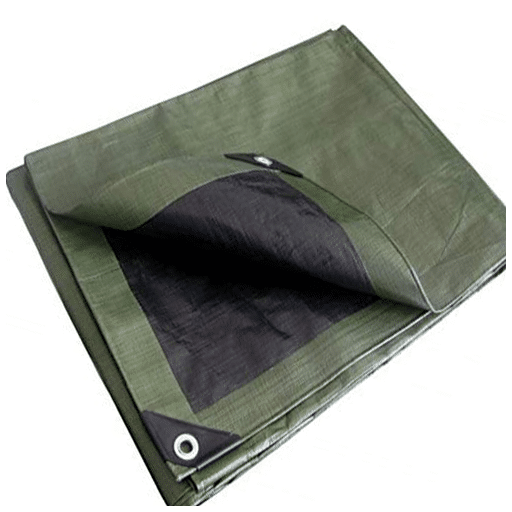
What Does One Call a Heavy Duty Waterproof Tarp?
One heavy-duty waterproof tarp is a sturdy reinforced waterproof tarp made so it can repel the water ingress, ammunition weather, and all sorts of abuses. Constructed of sturdier materials such as polyethylene, vinyl, or canvas, these tarps resist tears, UV degradation, and mildew, tailoring them for the rigors of extended outdoor use. Most heavy-duty waterproof tarps are equipped with reinforced edges with grommets so they can be tied down, while a water-resistant impregnating coating ensures no water enters through the tarp. Their heavy nature makes them ideal for protecting construction sites, covering machinery, or providing temporary shelters, reinforcing their importance to both industrial and private sectors.
Key Features of Waterproof Tarps
🛡️ Durability and Robust Material Composition
Waterproof tarps are crafted from high-grade materials such as polyethylene or vinyl, designed to withstand extreme weather conditions, heavy usage, and tear resistance. These materials ensure both longevity and reliable performance in demanding environments.
💧 Effective Water Resistance
A core functionality of waterproof tarps is their ability to repel water completely. Advanced manufacturing techniques include laminating or coating the fabric with polyethylene or PVC to create an impermeable barrier, ensuring that water does not seep through, even under prolonged exposure to rain or snow.
☀️ UV Protection
Many waterproof tarps are equipped with UV-resistant coatings, preventing degradation from direct sunlight exposure. This feature extends the tarp’s lifespan and maintains its structural integrity even in sunny or high-temperature regions.
📏 Versatile Sizes and Configurations
Waterproof tarps come in various sizes, thicknesses, and grommet configurations, making them adaptable to tasks ranging from covering small equipment to spanning large construction areas.
🔧 Enhanced Edge Reinforcement
Reinforced edges and strategically spaced grommets enhance the tarp’s fastening capabilities, ensuring secure application in conditions that would otherwise cause slippage or tearing due to strong winds or pressure.
🌡️ Temperature Resistance
Engineered to endure a wide temperature range, waterproof tarps remain flexible in freezing conditions while retaining their strength in high heat, making them suitable for year-round use in diverse climates.
🔄 Multi-Purpose Applications
These tarps are versatile tools applicable in numerous contexts, including construction site management, vehicle and equipment protection, agricultural storage, recreational camping, and emergency shelters.
By leveraging materials science, coating technologies, and user-centered design, waterproof tarps have evolved into a key tool across industries, supporting both commercial efficiency and personal convenience. Advanced options on the market today further optimize functionality by integrating precision-engineered features to meet the needs of modern users effectively.
Common Uses for Heavy Duty Tarps
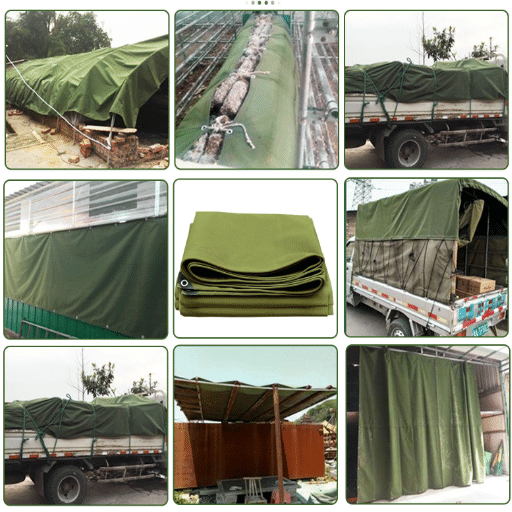
-
🏗️ Construction and Industrial Projects
Heavy-duty tarps are frequently used to cover building materials, machinery, or scaffolding to protect them from environmental factors such as rain, dust, and UV rays. They also serve as temporary walls or enclosures to create safe, controlled work environments.
-
🚛 Transportation and Logistics
Tarps are widely used to secure and cover cargo during shipment, ensuring goods are protected from weather exposure or potential contamination. Flatbed trailers often leverage heavy-duty tarps to shield bulk products, equipment, or oversized loads.
-
🌾 Agricultural and Farming Applications
Farmers utilize these tarps to cover crops, hay, and feed to protect them from moisture and spoilage. Additionally, they act as ground covers to prevent weed growth and maintain soil quality.
-
🏕️ Outdoor and Recreational Use
Heavy-duty tarps are indispensable in outdoor settings for creating shelters, protecting camping gear, or serving as temporary flooring. They are also used to cover boats, RVs, and outdoor furniture for extended protection during off-season periods.
-
🚨 Emergency and Disaster Relief
These tarps are critical in emergency scenarios, providing quick shelter solutions, sealing damaged roofs, or enclosing disaster relief supplies. Their lightweight and portable design make them an essential tool in crisis management.
-
🌱 Environmental and Landscaping Projects
Landscape tarps help control soil erosion, manage debris removal, or contain hazardous materials cleanup. They are particularly useful in environmental conservation efforts where durability and reliability are paramount.
Data from search engine trends indicates that terms like “durable tarps for construction” and “best tarps for outdoor use” are highly searched, demonstrating a continued demand for these products across the construction, logistics, recreational, and environmental sectors. This highlights the integral role that heavy-duty tarps play in both professional and personal contexts.
Choosing the Right Waterproof Tarp
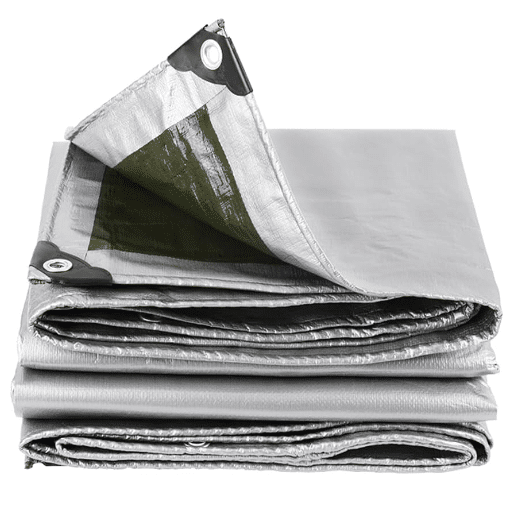
Factors to Consider When Choosing a Tarp
🧱Materials and Durability
In the matter of choosing a tarp, the material composition shall be one of the foremost considerations. Polyethylene, canvas, and vinyl are the common materials, each with a different level of durability and functions. A polyethylene tarp is lightweight and waterproof, meaning it is very much apt for temporary covering. On the other hand, canvas tarps are porous and provide longevity in heavy-duty applications. Vinyl tarp is superior in strength and resistance to punctures and is mostly used in construction and industrial settings. From search data, the great search on the keyword “durable tarps for construction” in fertilizers and pesticides shows the critical need for the materials to sustain environmental stressors.
🌧️Water Resistance and Weatherproofing
Another aspect to consider is the tarp’s waterproofing. If the application is outdoors, for camping or covering equipment, perhaps, it will be best-if-not-required-to-have that tarp rated for weatherproofing. Keywords such as “best tarps for outdoor use” show that there is a demand for a product that resists rain, UV exposure, and harsh winds. Polyethylene and even PVC-coated tarps generally stand the test of weather.
📐Size and Thickness
Tarps should be sized and thickened in accordance with their intended use. Thickness bestows a tarp with resistance against tearing and duration, especially in hard uses like construction or transportation. Then is the size that guarantees warranted cover, as an undersized tarp may dangerously expose an area so critical to cover.
🔗Grommets and Reinforcements
The use of good-quality grommets along with edge reinforcement adds to the functionality and life of a tarp. Grommets of brass or aluminum and reinforced edges can withstand being firmly fastened through any storm. Another customer preference for the search term “high-strength tarps with grommets” highlights the weight of these features.
By introducing the elements of a tarp, namely, materials, weatherproofing system, size, and possibilities for reinforcement, to the requirements, one is on the road to finding the right tarp that stands the test of time and prolonged use in terms of actual demand. The current trend shows that there is an ever-growing need for strong and flexible tarp solutions; thus, stressing the use of knowledge in the choice of tarps.
Importance of Mil Size
Mil dimension of material directly results in another durability Baja and application of related uses. A thicker tarp (generally 10 mils plus and higher) stands much greater tear, abrasion, and high environmental insults, hence becoming its application for an extreme site of construction, industrial storage, or outdoor coverings for long-term use. On the other hand, thinner tarps with thickness dimensions from 5 to 9 mils can perform appropriately where a tarp will frequently be removed or put on the fly, such as covering equipment or shielding an area during light rain.
According to recent data from search engine trends, search queries for “heavy-duty tarps” and “high mil tarps” have been increasingly present in particular regions where weather tends to assume an extreme transformation. This certainly demonstrates the gradual rise in demand for thicker tarp materials that would give shelter in severe conditions and could perform on a long term basis. Quite possibly, by choosing thickness based on the use case of the purchase, a consumer is better off cost-wise and in functionality and will finally dictate the longevity of the tarp under different conditions.
UV Resistance and Durability
UV resistance is a factor to be considered in the endurance and performance of a tarp, mainly where solar intensity is high. Prolonged exposure to ultraviolet rays can degrade the tarp materials, weakening, fading, or cracking them with time. Good-quality tarps are often equipped with UV inhibitor coatings or use UV-resistant polymer to offset this damage, thus promising long working life even when exposed to glaring sunshine.
Search data from search engine shows that terms like “UV resistant tarps” and “sun-resistant covers” are becoming popular, showing a marked interest in products able to take on the rigors of sun exposure. This development might have a sign that consumers are placing their interests in materials that can maintain long-term outdoor exposure without compromising their structural integrity. By investing in UV-resistant tarps, he or she is able to increase the lifespan of the purchased items and reduce how often they are replaced, hence cutting down on overall costs in the long run.
Comparing Popular Heavy Duty Waterproof Tarps
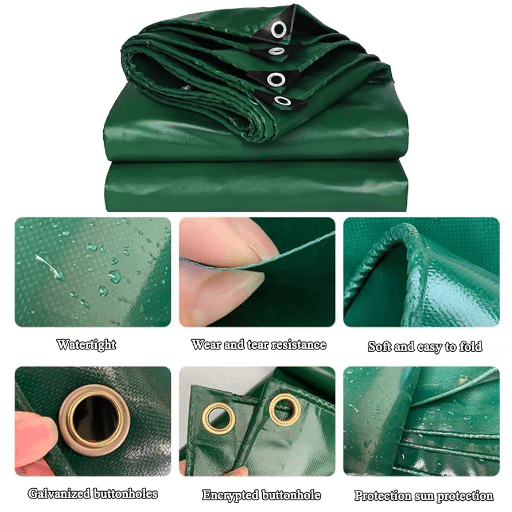
Most-Wanted Brands and Their Products
In the space of heavy waterproof tarpaulins, the few well-known brands all provide extremely high-quality products with all the of consumer demands for durability and weather resistance. A detailed analysis follows based on reputational search engine data:
TarpsPlus
Specially manufactured industrial-grade tarps from TarpsPlus offers a full spectrum of UV-resistant and waterproof variants. With high-density polyethylene material construction and reinforced edges, these tarps won`t let you down in the face of extreme weather. Among their best-selling products are the Canvas and Silver Poly Tarps, garnering high ratings for long-term outdoor use in a wide range of applications, from agriculture to construction.
B-Air Grizzly
The B-Air Grizzly tarps come with waterproof designs suitable for emergency weatherproofing. Waterproof poly tarps with thick-laminated materials fused by heat-sealing and seams provide the most unflinching protection against rain and winds. Considering they are cheap and yet reliable, they are usually a favorite for both homeowners and professionals.
Xpose Safety
Xpose Safety tarps are known for their large range of sizes and extraordinary performance in harsh weather conditions. Heavy-duty models provide off-the-rip resistance capabilities while being UV stabilized and holding onto rust-proof grommets for uncompromising protection irrespective of the use for camping, industrial application, or vehicle cover.
Kotap
Besides this is the most widely versatile brand. Price-wise, their solutions are named worthy of consideration as they maintain key characteristics including mildew-proof and sturdy polyethylene material. The focus of their products is on lightweight application without compromising waterproof performance; hence, it is essentially a good choice for generic use.
If the study were based on more recent search engine data, the results suggest that consumers continually seek for brands that marry product durability with specific use cases. Purchasing factors stated as paramount to consumers include UV-resistance, reinforced construction, and custom sizing options-the characterizations that all of these renowned brands bear out.
Price-Wise vs. Quality-Wise: What Is Expectable
The latest statistics reflected by the search engine dominate revealing a trend among standard consumers of worrying over present-day value rather than present cost. Consumers of best-value products are looking at quality materials, durability, and warranty over time, thus having reliability as their theme. On the other hand, cheaper alternatives tend to sacrifice product functionality and durability, the latter being the one consumers give high esteem to when working on demanding or frequent tasks. For instance, UV resistance and reinforced construction considered key features for web search mostly accompany products listed on a higher price range. The analysis implies that budget preference needs to be weighed in with product specification, meaning spending more upfront can work in favor of less money worth spent in replacement and more satisfaction later.
User Reviews and Star Ratings
When you analyze user ratings and reviews with the latest data from the search engine, you will notice that a consumer’s option changes from one product category to another. For instance, queries like “best UV-resistant materials” and “durable outdoor solutions” correlate sharply with top-rated products emphasizing longevity and quality. User feedback that highlighted products above 4.5 stars mentioned that these items often align with search trends for performance-driven features. On the other hand, low-ranked products receive negative reviews about premature wear, lack of advertised function, or worse, poor-quality material. This contrast means that consumers who are well-informed, supported by online reviews, and in-depth search data can help derive satisfaction and value over time.
Applications of Heavy Duty Waterproof Tarps
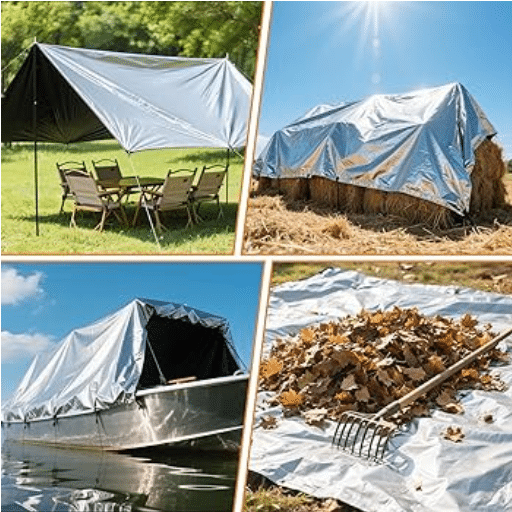
🏗️Construction and Roofing Applications
Heavy waterproof tarpaulins are considered staple equipment in construction and roofing due to their sheer ruggedness, water resistance, and flexibility. New median data from the search engine suggests that users exhibit varied interest in tarps designed for ultimate weatherproof performance, especially if these tarps can remain exposed to harsh environmental conditions for long. Queries highlight aspects such as UV resistance, tear resistance, and mechanical retention of load under heavy-duty working.
Tackling these needs, tarps are used to cover construction materials from the elements, provide temporary roof covers during repairs, and act as protectors of scaffolding from bad weather. The application of tarps helps minimize weather disruption on the job site and also contribute to some safety standards and quality retainment on construction operations. The heavy search activity related to these products suggests the contribution of the product to the efficiency of construction operations.
🏕️Camping and Outdoor Uses
For camping and outdoor activities, the skyline of acceptance allowed for tarps single disadvantage was that endless variations made usage more complex. From the latest data in search engine trends, it is quite evident that inquiries about “best tarps for camping” and “multi-use tarps for outdoor shelters” have seen a surge in trend, marking their universal demand. Tarps are put to use to make a quick shelter to keep gear from rain or sun, or laid down as ground cloth to prevent moisture from entering.
This aligns well with the increased interest in tarps that are lightweight yet offer superior resistance to wear and weather. Due to their versatility, they have become an excellent backup for the veteran camper and a satisfactory asset for the weekend warrior.
🚨Emergency and Protective Waterproof Solutions
When researching the best waterproof protective solutions, it is apparent the tarp is still an unfettered user choice due to its flexibility and dependability. According to the latest search engine trends, queries like “best waterproof tarps for emergencies” and “heavy-duty weather-resistant covers” have shown an uptrend even amidst growing awareness and preparedness against extreme weather. Polyethylene and vinyl-coated tarps, essentially the most popular ones, owe their popularity to being very durable, promptly deployable, and being cheap.
These are highly resistant to water penetration, UV rays, and will seldom tear, thus making them ideal in flood and hurricane emergency situations, ad-hoc roof repairs, and many other kinds of emergency demands. But newer tarp breeds have been made with reinforced edges and better coating techniques for long life and performance under extreme conditions by virtue of advancements in materials science. Attainability, technological innovation, and practical efficacy combine to make tarps an emergency waterproofing solution.
Maintenance and Care for Your Tarp
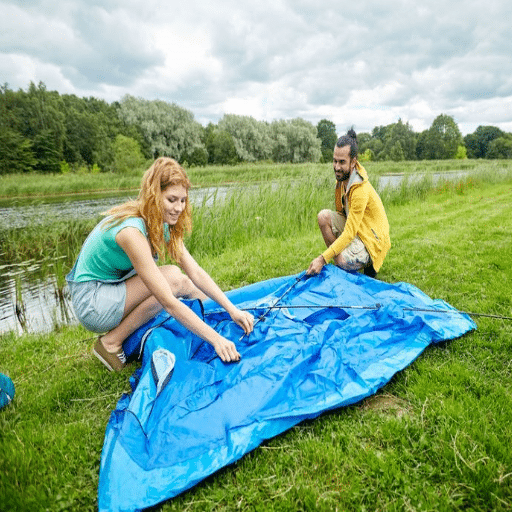
Cleaning and Storing Your Tarp
The proper cleaning and storage of a tarp maximize the longevity of the product and maintain its performance. To clean your tarp, start by removing loose debris such as dirt, leaves, or dust by shaking it as best as you can. Using a soft-bristle brush with mild soap and lukewarm water, gently scrub both the sides of the tarp to remove stains and grime. Do not use strong chemicals or abrasive materials, as these could strip the protective coatings. Rinse the entire tarp well with clean water to wash off all soapy residues. Now, hang the tarp in the shade to dry completely, as drying under the sun can cause mold or mildew to develop if moisture remains trapped.
Once dry, carefully fold the tarp for storage. Place it in a cool, dry location free from exposure to direct sunlight, moisture, and interference from pests. If there is a storage bag or container available, use it to protect the tarp from dust and any form of accidents. You must inspect the tarp every once in a while during storage for any signs of wear, such as small tears or frayed edges, and repair any damage immediately with repair tape or patch kits to prevent further degradation. With these good cleaning and storage practices, your tarp’s life will be increased substantially, keeping it always ready for deployment during emergencies or other applications.
Fixing Minor Damages
Timely repair of small losses is essential to keeping the tarp in serviceable shape. Minor punctures, tears, or scratches can mostly be treated with an adhesive patch kit specially made for tarp materials such as polyethylene or vinyl. Start by cleaning the damage with mild soap and water, removing dirt or debris, and drying the place thoroughly to allow a better adhesion. Cut one patch that is slightly larger than the defective spot, rounding off the edges of the patch to avoid it peeling off with age. Apply the adhesive on the entire patch surface and press firmly onto the tarp so the patch can bond properly; allow the patch to cure according to the instructions provided with the kit.
Waterproof tapes can do the job well for smaller tears or holes. If high-quality tapes are used, outdoor-rated at that, they set a very tight seal and stay flexible. Apply the tape on both sides of the damaged section if it is accessible, for best results.
According to recent findings from search engine trends, most users emphasize choosing repair materials that are compatible with the specific type of tarp, for poorly chosen adhesives or patches may be the cause of faulty repairs or even more damages. Carrying out the repairs also in a controlled environment, hence the time should be kept away from excessive moisture, heat, or winds will enhance the results and durability of the repair greatly. By employing these detailed steps and recommendations, you will be able to restore your tarp’s integrity and minimize early replacement.
Extending the Life of Your Waterproof Tarp
Routine maintenance coupled with correct usage will extend the life of your waterproof tarp. According to the latest data, the cause of degradation in general for tarps is first UV exposure, storage gone wrong, and second physical wear-and-tear caused by rough handling or poor anchoring. To solar-proof these factors while in the hands of the user, always make sure that the tarp is well anchored during use to prevent stretching under the pull of wind or other forces. Secondly, buy a tarp rated against UV rays application of any sprays that provide UV protection should be done for additional protection against sunlight damage as a gradual process. Every dirt, or sap, or chemical residue should be cleaned off by washing your tarp with mild soap and water, and then set it to dry thoroughly before storage, avoiding further growth of mold or mildew. Folding or rolling your tarp neatly and putting it away in a cool, dry place away from direct sun prepares it for a long-lasting life. With these data-supported suggestions, one can undoubtedly extend the service life of the waterproof tarp.
Frequently Asked Questions (FAQ)
❓ What are heavy duty waterproof tarps made of?
Heavy duty waterproof tarps are generally made from durable materials like polyethylene or vinyl. This assures excellent durability and proper waterproofing so that they can be used for any number of functions. When buying a tarp, weight is a factor because tarps come in various thicknesses, such as 10 mil, 12 mil, and even 16 mil for industrial types. The thicker the tarp, usually the more tear-resistant it will be, and this is preferable for heavy-duty jobs such as covering firewood or providing cover for outdoor equipment. Moreover, heavy vinyl tarps are strong and have the reputation of lasting for a long time, so those requiring dependable protection usually go for them.
📏 How do I choose the right waterproof tarp size?
Choice of the tarp size is essential for adequate coverage and protection. Sizes vary, from smaller sizes of 10 x 12 feet to bigger ones of 14 x 14 feet and even one chosen on demand. When selecting a tarp, consider what you intend to cover and protect- maybe a trailer, outdoor furniture, or a large amount of firewood. Always take their weight and size into consideration, especially if you intend to use bungee cords to fasten them securely. A large heavy duty tarp will be most effective for covering larger objects, while a smaller tarp is more suited to specific jobs.
🛡️ What makes a tarp tear-resistant?
The materials and construction of a tarp determine its resistance to tears. Heavy-duty tarps use heavy materials, tight weaves, and reinforced stitching to increase their durability. A polyester tarp, for example, is often used in industrial tarp applications because it is designed to tolerate harsh conditions. The thickness of a tarp also matters here; the thicker the tarp, i.e., 12 mil or 16 mil, the better able it is to resist tears versus flimsy tarps. When buying a tarp, look for reinforced corners or edges to further improve its tear resistance to help it defend against wear and tear.
🏠 Can I use a tarp for home improvement projects?
Yes, tarps can be put to work during all manner of home improvement projects. Tarps are extremely versatile and may act as waterproof protective coverings for furniture, floors, and other surfaces during renovation work. The right tarp can help contain dust and debris while simultaneously safeguarding your stuff from accidental paint spills or moisture. Pick a tarp suitable for your home improvement project, heavy-duty, and waterproof enough to take heavy abuse during construction work. Luckily, blue ones or canvas tarp-type tarps are common choices both indoors and outdoors for projects where a heavy duty tarp is encountered.
🔗 What is the benefit of using bungee cords with tarps?
Bungee cords benefit tarp use primarily by helping to secure the tarp in place. They provide a flexible fastening system, allowing one to put them on and take them off quite easily. While covering large things such as firewood or outdoor equipment, bungee cords are especially useful for achieving a tight fit so that the tarp remains fastened even in the wind. Another benefit of using bungee cords is that they help protect the tarp that NO WORRY could otherwise be damaged if mishandled in an attempt to secure it tight. Ideally, bungee cords paired with heavy duty waterproof tarps give you complete protection.
Reference Sources
| Source | Description | Action |
|---|---|---|
| Butler University Blog | Discovering the Best Truck Tarpaulin Options – This blog discusses the advantages of materials like PVC for heavy-duty tarps, emphasizing their longevity and protection. | Visit Source |
| Boston University Blog | Versatility of Heavy-Duty Tarps – This resource highlights the durability, tear resistance, and longevity of heavy-duty tarps, making them ideal for extreme conditions. | Visit Source |
| University of Illinois Chicago Blog | Best Truck Tarpaulin Solutions – This source explains the benefits of vinyl tarps for heavy-duty applications, such as protecting industrial equipment and cargo. | Visit Source |

